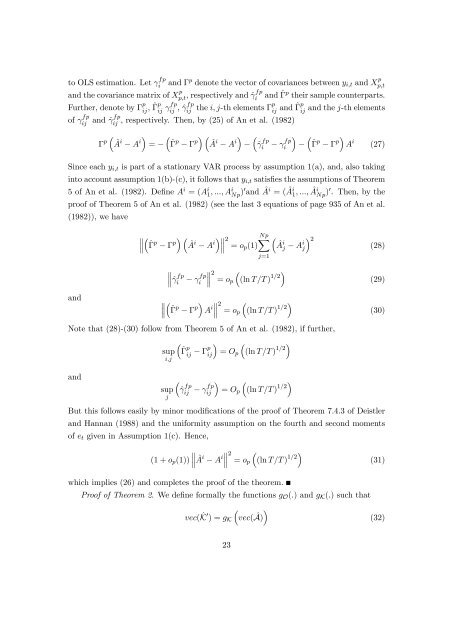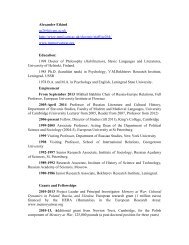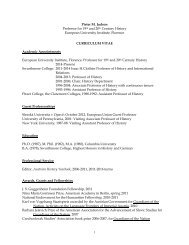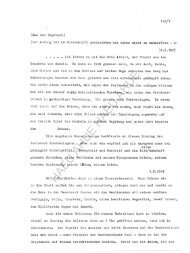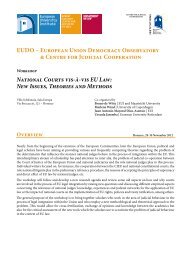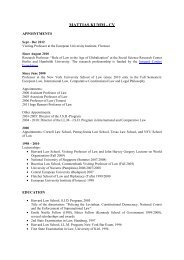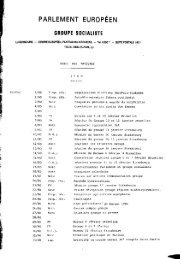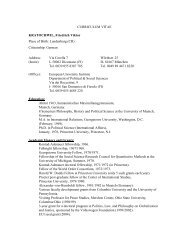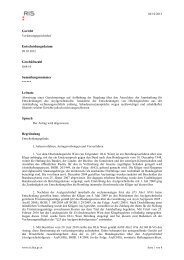Forecasting Large Datasets with Reduced Rank Multivariate Models
Forecasting Large Datasets with Reduced Rank Multivariate Models
Forecasting Large Datasets with Reduced Rank Multivariate Models
Create successful ePaper yourself
Turn your PDF publications into a flip-book with our unique Google optimized e-Paper software.
fp<br />
i and p denote the vector of covariances between yi;t and X p<br />
p;t<br />
to OLS estimation. Let<br />
and the covariance matrix of X p<br />
p;t , respectively and ^fp<br />
Further, denote by p<br />
, ^fp the i; j-th elements<br />
of<br />
fp<br />
ij<br />
and ^fp<br />
ij<br />
ij<br />
, ^p<br />
ij<br />
fp<br />
ij<br />
ij<br />
i and ^p their sample counterparts.<br />
p<br />
ij<br />
and ^p<br />
ij<br />
, respectively. Then, by (25) of An et al. (1982)<br />
p ^ A i A i = ^p p ^ A i A i<br />
^ fp<br />
i<br />
fp<br />
i<br />
and the j-th elements<br />
^p p A i<br />
Since each yi;t is part of a stationary VAR process by assumption 1(a), and, also taking<br />
into account assumption 1(b)-(c), it follows that yi;t satis…es the assumptions of Theorem<br />
5 of An et al. (1982). De…ne A i = (A i 1 ; :::; Ai Np )0 and ^ A i = ( ^ A i 1 ; :::; ^ A i Np )0 . Then, by the<br />
proof of Theorem 5 of An et al. (1982) (see the last 3 equations of page 935 of An et al.<br />
(1982)), we have<br />
and<br />
^p p ^ A i A i<br />
^ fp<br />
i<br />
fp<br />
i<br />
2<br />
XNp<br />
= op(1)<br />
j=1<br />
2<br />
= op (ln T=T ) 1=2<br />
^A i j<br />
^p p i<br />
A 2<br />
= op (ln T=T ) 1=2<br />
Note that (28)-(30) follow from Theorem 5 of An et al. (1982), if further,<br />
and<br />
sup<br />
i;j<br />
sup<br />
j<br />
^ p<br />
ij<br />
^ fp<br />
ij<br />
p<br />
ij = Op (ln T=T ) 1=2<br />
fp<br />
ij = Op (ln T=T ) 1=2<br />
But this follows easily by minor modi…cations of the proof of Theorem 7.4.3 of Deistler<br />
and Hannan (1988) and the uniformity assumption on the fourth and second moments<br />
of et given in Assumption 1(c). Hence,<br />
(1 + op(1)) ^ A i 2<br />
i<br />
A = op (ln T=T ) 1=2<br />
which implies (26) and completes the proof of the theorem.<br />
Proof of Theorem 2. We de…ne formally the functions gO(:) and gK(:) such that<br />
A i j<br />
2<br />
(27)<br />
(28)<br />
(29)<br />
(30)<br />
(31)<br />
vec( ^ K 0 ) = gK vec( ^ A) (32)<br />
23


